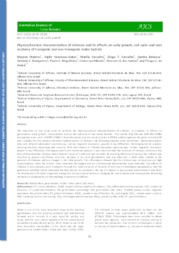Physicochemical characterization of chitosan and its effects on early growth, cell cycle and root anatomy of transgenic and non-transgenic maize hybrids.
Physicochemical characterization of chitosan and its effects on early growth, cell cycle and root anatomy of transgenic and non-transgenic maize hybrids.
Author(s): MARTINS, M.; VERONEZE JÚNIOR, V.; CARVALHO, M.; CARVALHO, D. T.; BARBOSA, S.; DORIGUETTO, A. C.; MAGALHAES, P. C.; RIBEIRO, C.; SANTOS, M. H. dos; SOUZA, T. C. de
Summary: The objectives of this study were to perform the physicochemical characterization of chitosan, to evaluate its effects on germination, early growth, root anatomy and on the cell cycle of two maize hybrids. The hybrids DKB 390 and DKB 390 VTPRO (transgenic) were used. DKB390 VTPRO is from Monsanto, and the event number is 89034, which expresses the proteins Cry1A105 and Cry2AB2. For the physico-chemical characterization of chitosan, the following analyzes were performed:, elemental analysis, total ash, infrared absorption spectroscopy, nuclear magnetic resonance, powder X-ray diffraction, thermogravimetric analysis, scanning electron microscopy and viscosity. With the analysis of infrared absorption spectroscopy, nuclear magnetic resonance, powder X-ray diffraction, thermogravimetric and elemental analysis it was observed that the structure of chitosan presents a low level of deacetylation. Chitosan had a total ash value of 1.32% and high viscosity. By scanning electron microscopy the chitosan was classified as porous and fibrous structure. Increase in the seed germination rate was observed in both maize hybrids in the presence of chitosan, without changes in the initial growth. The cell analyzes showed that the chitosan was not toxic even at high concentrations, since the mitotic index remained unchanged and no chromosomal abnormalities were detected. The effects of chitosan in root anatomy were evaluated through the measurements of sections of root tips on histological preparations, and the genetically modified hybrid presented the best results. As conclusion, the use of chitosan in appropriate concentrations may favor the development of maize (especially transgenic) acting on germination or changing the root anatomy and consequently increasing resistance and adaptation of the seedlings to adverse conditions.
Publication year: 2018
Types of publication: Journal article
Unit: Embrapa Maize & Sorghum
Keywords: Hibrido, Milho, Propriedade Físico-Química, Quitosana
Observation
Some of Embrapa's publications are published as ePub files. To read them, use or download one of the following free software options to your computer or mobile device. Android: Google Play Books; IOS: iBooks; Windows and Linux: Calibre.
Access other publications
Access the Agricultural Research Database (BDPA) to consult Embrapa's full library collection and records.
Visit Embrapa Bookstore to purchase books and other publications sold by Embrapa.

